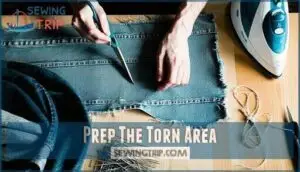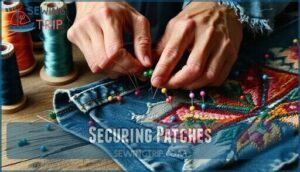This site is supported by our readers. We may earn a commission, at no cost to you, if you purchase through links.
 To sew a tear, first clean the fabric edges and thread your needle with matching thread.
To sew a tear, first clean the fabric edges and thread your needle with matching thread.
For small rips, use tiny running stitches close together, working from one end to the other.
Pull gently to close the gap without puckering.
For L-shaped or larger tears, start at the corner and work outward.
Keep stitches small and even – think of it like putting a puzzle back together, one piece at a time.
Knot securely on the fabric’s wrong side when finished.
The right technique depends on your fabric type and tear size, but patience always pays off, and using the correct method is key to a successful repair, which requires matching thread and a gentle touch to avoid puckering.
Table Of Contents
Key Takeaways
- Assess the tear first – You’ll need to examine whether it’s a clean rip or an open hole, identify your fabric type, and check for fraying before choosing your repair method.
- Match your thread and needle – You should select thread that matches your fabric’s color and weight, plus choose the right needle size for your material to prevent further damage.
- Use proper technique for tear type – You’ll want to use running stitches for small rips, the backstitch for high-stress areas, and zigzag stitches for stretchy fabrics to ensure lasting repairs.
- Prepare the area properly – You need to trim loose threads, press the fabric flat, and align the edges correctly before stitching to create professional-looking results that won’t unravel.
Assess The Tear
Before diving into repairs, you need to properly assess what you’re dealing with. Start by examining the rip characteristics—is this a clean rip with edges that meet, or an open hole with missing fabric? Fabric identification matters too, since delicate materials like silk require different handling than sturdy denim.
Understand the tear—clean or open—and match your approach to the fabric, from delicate silk to rugged denim.
Next, determine the tear cause. Sharp snags create different damage patterns than gradual wear and tear. This knowledge helps you prevent future problems and choose the right repair approach.
Carefully evaluate the damage extent by gently pulling the fabric edges together. Can they reunite cleanly, or are pieces missing? Check for fraying around the edges and note any weak spots nearby.
This tear assessment determines your repair feasibility. Understanding these tear types upfront makes sewing tear repairs much more successful and guarantees your fix will last.
Prep The Torn Area
Once you’ve identified your tear type, proper fabric preparation sets the foundation for a durable repair that won’t unravel later.
Think of fabric preparation as creating the perfect canvas for your sewing work. Clean edges and smooth surfaces make all the difference between a repair that lasts and one that fails after the first wash.
Follow these steps to prepare your torn area:
- Thread trimming: Use sharp scissors to cut away loose threads and frayed edges without enlarging the tear itself.
- Ironing fabric: Press the damaged area flat using appropriate heat settings for your material type.
- Interfacing types: Apply iron-on interfacing behind thin fabrics or clean rips for extra strength.
- Grain alignment: Match the fabric’s natural weave direction while considering stretch properties for natural-looking results.
Proper tear assessment guides your fabric preparation approach. Different materials require different handling – delicate silk needs gentler treatment than sturdy denim. For delicate fabrics, consider using fine pins to avoid marking the material.
Taking time with these preparation steps prevents future problems and creates professional-looking results that withstand regular wear.
Select a Mending Method
You’ll need to choose between hand stitching and machine stitching based on your fabric type and the precision required for your repair.
Hand stitching gives you complete control over delicate fabrics, while machine stitching works faster for sturdy materials and straight tears.
Hand Stitching
Hand stitching offers precision and control for mending tears. Select sharp needles matched to your fabric weight and thread polyester or cotton-wrapped polyester for durability. Master proper knot tying at both ends to secure your work.
Selecting the right thread guarantees project durability and appearance.
| Stitch Types | Best For | Technique |
|---|---|---|
| Running stitch | Light repairs | Small, even stitches |
| Backstitch | Strong seams | Overlap previous stitch |
| Ladder stitch | Invisible stitching | Alternate between fabric edges |
| Blanket stitch | Decorative mends | Loop thread under needle |
Maintain consistent thread tension—too tight causes puckers, too loose creates weak repairs. Keep stitches 1-2mm apart for strength. Start stitching beyond the tear’s edges for reinforcement. These hand sewing techniques create lasting repairs.
Machine Stitching
Machine sewing offers speed and precision for rip repair. Your sewing machine handles tears efficiently when you adjust tension settings to prevent puckering and select proper needle selection for your fabric weight.
Use zigzag stitch for stretch fabrics or straight stitch for clean tears. Set appropriate stitch length (2-2.5mm works well) and let consistent fabric feed guide smooth stitching.
Decorative stitches can turn visible repairs into design features while machine stitching creates durable results. For larger damage, consider using a sturdy patch fabric for reinforcement.
Stitch The Tear
With your mending method selected, you’re ready to stitch the tear back together. The key lies in choosing appropriate stitch types for your specific fabric and damage. Straight stitches work perfectly for clean rips, while zig-zag patterns handle stretchy materials that need flexibility. Knowing about different stitch options can improve your mending results.
Follow these essential steps for professional results:
- Control your tension – Too tight creates puckering, too loose won’t hold the repair fabric securely
- Match the seam – Align edges precisely to maintain the garment’s original shape and appearance
- Secure with knots – Backstitch at both ends to prevent unraveling during regular wear
Start stitching slightly beyond the tear’s endpoints to guarantee complete coverage. Work with the fabric stretch rather than against it, maintaining steady pressure throughout. This sewing tutorial approach prevents future failures at stress points.
Remember that proper knot securing makes the difference between a temporary fix and lasting rip repair that withstands washing and daily use.
Patch Larger Holes
When you’re dealing with holes larger than a simple tear, you’ll need to use a patch to provide the missing fabric structure.
Proper measuring and securing techniques guarantee your patch blends seamlessly with the original fabric and creates a durable repair.
Measuring
Measure your tear’s rip length and width precisely, then add 1.5 inches for seam allowance.
When selecting repair fabric, match the original fabric grain direction for ideal tension balance.
Cut your patch size with rounded corners to prevent fraying.
Accurate measuring guarantees your rip repair blends seamlessly with the surrounding material.
This careful preparation makes the difference between a visible patch and professional-looking fabric patch work when you sew a tear.
Securing Patches
Position your fabric patch over the tear and secure it with 4-6 pins for larger patches or 1-2 pins for smaller ones, placing pins at least half an inch from edges.
This guarantees proper patch adhesion and prevents shifting during stitching.
Choose patches with good fabric compatibility to match your garment’s weight and stretch.
Iron-on patch types offer quick adhesive options, but reinforcing them with stitching creates superior border security.
Consider products for patch application to improve results.
Use stitch patterns like blanket stitch or zigzag around patch edges for securing patches effectively.
This combination of patching clothes techniques guarantees your fabric patching repair withstands regular wear and washing.
Creative Mending Ideas
Transform your tears into treasured details with creative mending techniques that celebrate repairs rather than hide them. Visible mending turns damage into decorative opportunities, letting you express personality while extending garment life.
Turn tears into triumphs—mending makes fashion more personal and planet-friendly.
These five approaches will inspire your sewing projects:
- Fabric appliqué patches: Cut bold, patterned fabric pieces to cover holes. Position decorative patches on top for statement looks, or use reverse appliqué for subtle peek-through effects.
- Embroidered patches with decorative stitching: Create floral motifs, geometric patterns, or custom designs around tears using colorful thread and varied stitch techniques.
- Upcycled materials patchwork: Layer fabric scraps, denim pieces, or vintage textiles to build textured, eye-catching repairs that add visual interest.
- Sashiko-inspired visible mending: Use running stitches in contrasting thread colors to create geometric patterns that reinforce weak areas while adding Japanese-inspired artistry.
- Mixed-media upcycled fashion elements: Incorporate buttons, lace trim, sequins, or metallic threads for unique, personalized touches that transform ordinary repairs into sewing inspiration.
Mending Tools to Use
Every successful clothing repair starts with the right sewing tools in your toolkit. Needle types matter—choose sturdy darning needles for thick denim or delicate sharps for silk fabrics. Keep various sizes handy for different mend clothing projects.
The right needle and thread make all the difference—match your tools to your fabric for repairs that last.
Thread selection determines durability. Match thread strength and color to your fabric, using polyester for stretch materials and cotton for most fabric repair tasks. Waxed thread prevents frustrating tangles during intricate work.
Sharp fabric scissors create clean cuts without frayed edges. Pinking shears add zigzag edges that resist unraveling. When pins aren’t available, safety pins or clips secure fabric layers effectively.
A thimble protects fingers when pushing needles through tough materials like canvas or multiple fabric layers. Seam rippers remove incorrect stitches cleanly without damaging surrounding fabric.
Mark stitching lines with washable chalk or fabric markers for precise needle and thread work. These essential sewing tools guarantee professional-looking repairs that withstand regular wear.
Frequently Asked Questions (FAQs)
What is the best stitch for mending a rip?
When your favorite jeans split at the knee, you’ll want the backstitch for its strength.
Use backstitch for high-stress areas like seams and knees.
For visible repairs, try ladder stitch—it’s nearly invisible and perfect for clean tears.
How do you sew a tear rip?
First, trim loose threads with sharp scissors to prevent fraying.
Iron the area flat, then align the torn edges together.
Use a backstitch or running stitch to close the tear securely.
How to repair small tears on fabric?
Small tears happen to everyone’s favorite clothes.
First, trim loose threads with sharp scissors to prevent further fraying.
Next, align the tear’s edges and use a running stitch or backstitch to close the gap.
Finish by pressing flat with an iron for a professional look.
How do you resew a tear in a sewing machine?
Turn your sewing machine’s handwheel to lift the needle.
Carefully position the torn fabric under the presser foot, aligning edges.
Lower the foot, then slowly stitch using short, even stitches to secure the repair.
How do you stitch a tear in fabric?
Stitching fabric tears isn’t rocket science! First, trim loose threads and press the area flat. Align torn edges, then use a running stitch or backstitch to close the gap securely.
How do you fix a rip or tear in fabric?
Assess the damage by examining the tear’s size and edges. Trim loose threads, then choose between hand-stitching for precision or machine-sewing for speed, using matching thread and appropriate reinforcement techniques.
How do you sew a rip?
Like mending a broken bridge one plank at a time, you’ll thread your needle, align the fabric edges, and use small, even stitches to close the gap securely.
How do I pick the right needle for the material I’m sewing?
Choose needle size based on your fabric’s weight and weave.
Heavy fabrics like denim need size 16-18 needles, while delicate materials require size 9-
Match the needle point to fabric type—universal for wovens, ballpoint for knits.
How do you repair frayed fabric edges?
Trim frayed edges with sharp scissors, cutting perpendicular to fabric grain. Press flat, then reinforce with iron-on interfacing or small stitches to prevent further unraveling.
What is the best stitch for stretchy fabrics?
Ninety percent of fabric tears occur in high-stress areas where standard stitches fail.
For stretchy fabrics, you’ll want zigzag or three-step zigzag stitches that flex with the material, preventing future breakage.
Conclusion
Mending mastery matters most when you’re committed to completing repairs correctly.
You’ve learned how to sew a tear using various techniques, from simple running stitches to creative patches.
Remember to assess each tear carefully, choose appropriate thread, and work patiently for lasting results.
With practice, you’ll transform damaged garments into treasured pieces again.
Keep your sewing kit stocked and ready—because knowing how to sew a tear saves both money and memories. Mending is about mastery that comes with experience.
- https://wrenbirdarts.com/blogs/embroidery-by-erin-eggenburg/basic-tools-for-beginning-menders
- https://www.reddit.com/r/Visiblemending/comments/w71zic/huge_tear_in_my_comforter_can_someone_please_tell/
- https://www.youtube.com/watch?v=pYuM0QheOxc
- https://www.tiktok.com/@sewing_lovers_school/video/7220806341714119942?lang=en
- https://madamsew.com/blogs/sewing-blog/hand-sewing-stitches-mending












